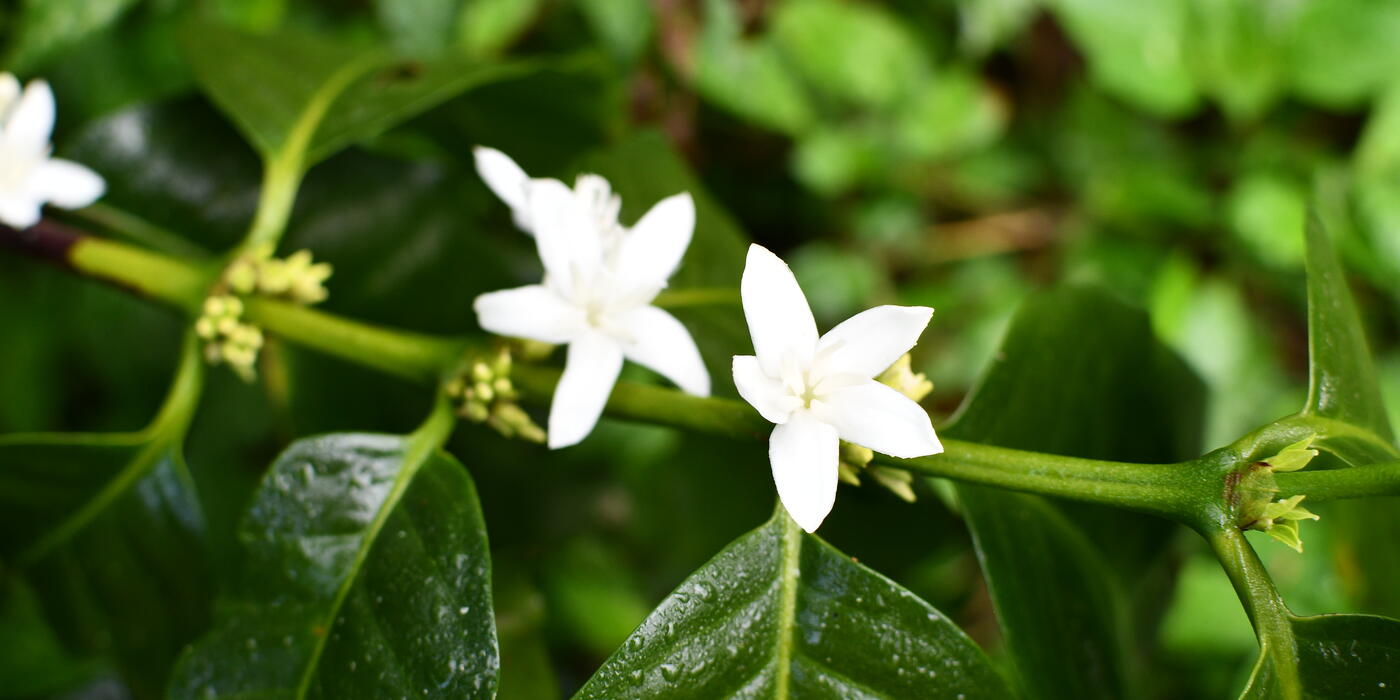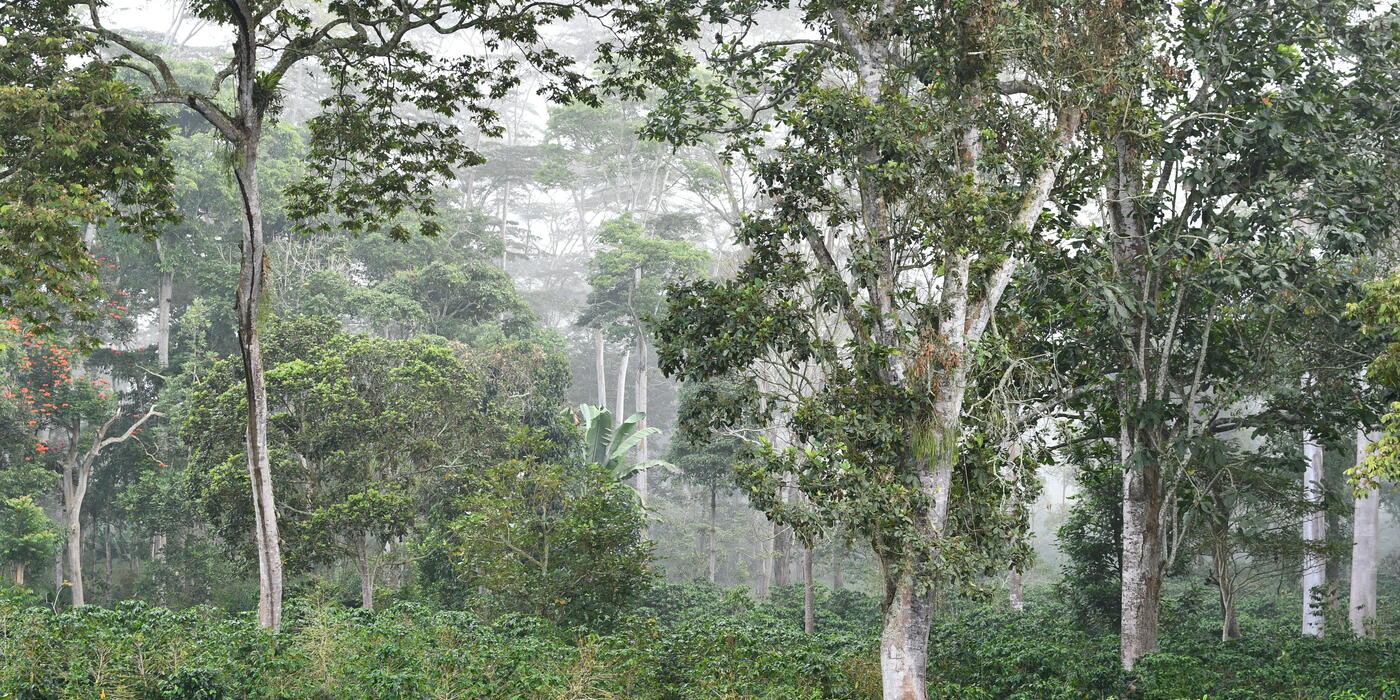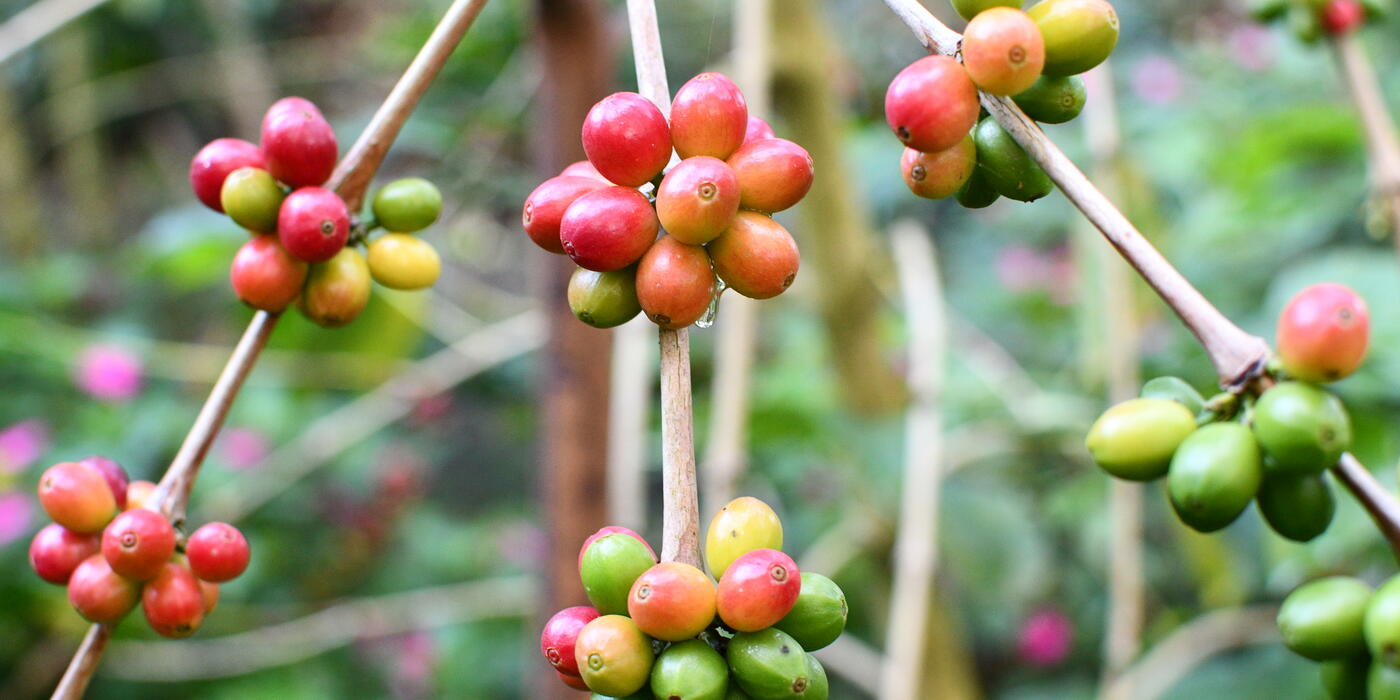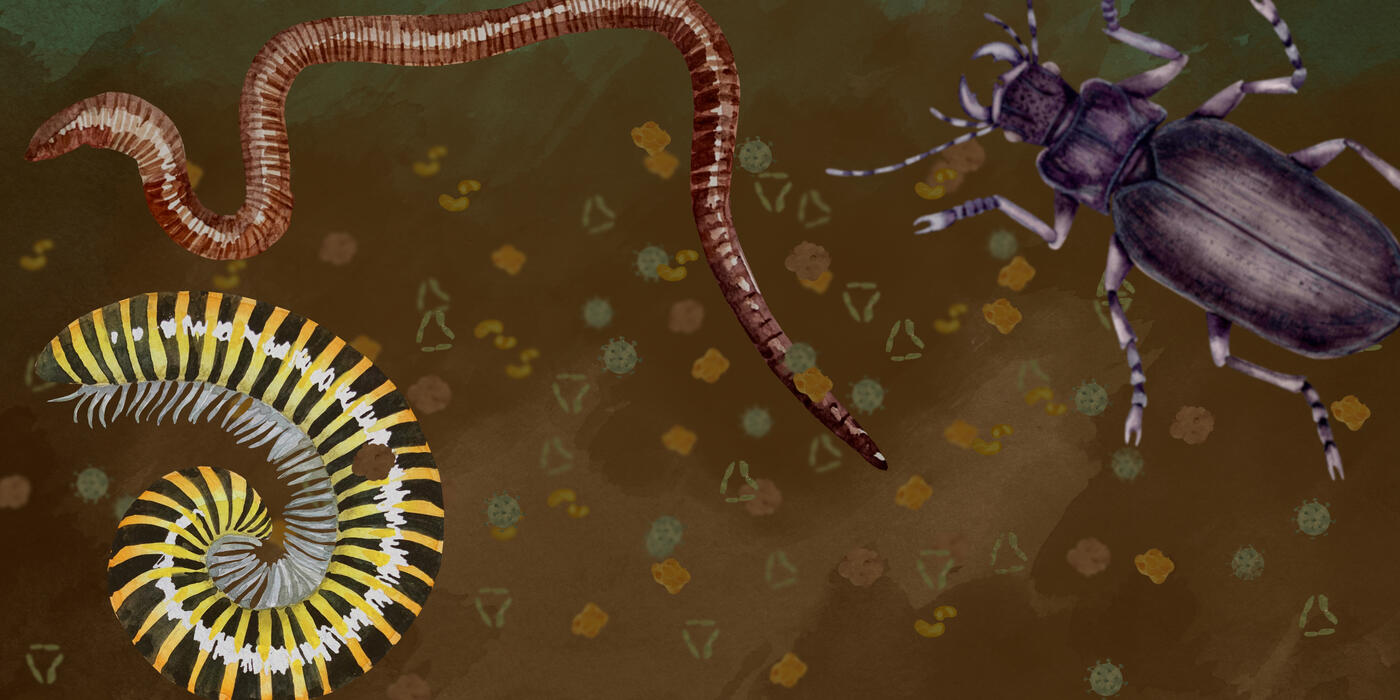Ecological Benefits of Shade-grown Coffee
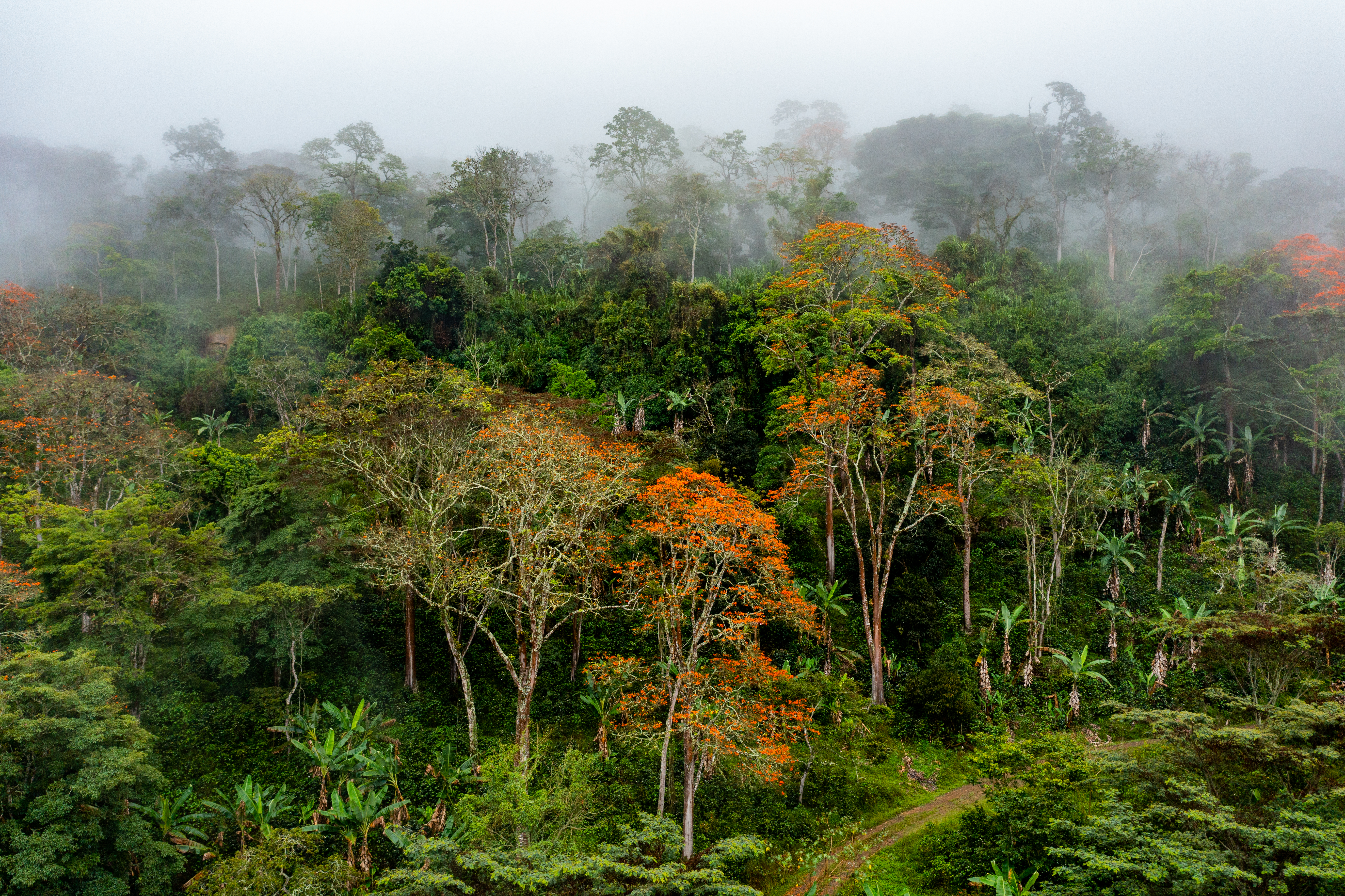
Bird Friendly coffee is certified organic and produced on farms with a shade cover that provides important habitat for migratory and resident birds in tropical landscapes, which are increasingly threatened by deforestation globally at an unprecedented rate. The Bird Friendly criteria are the world's most stringent standards for shade-grown coffee production.
At 34 million pounds, the total volume of Bird Friendly certified coffee produced has grown by 24 million pounds in the past decade with more than 5,100 participants managing farms from Mexico to Colombia and Ethiopia to Thailand. Bird Friendly habitat covers more than 37,000 acres around the world.
When the coffee reaches its final destination — where it is roasted, packaged and sold — roasters can use the Smithsonian Bird Friendly seal to market their Bird Friendly coffees to consumers. These pennies-on-the-pound royalty fees fuel the program, as well as the Smithsonian Migratory Bird Center’s cutting-edge ornithological research exploring the connections between birds, coffee and beyond. Excitingly, some of the following studies cited in Mexico and Costa Rica were supported with funds from royalties remitted to SMBC by roasters involved in the Bird Friendly program. These remittances paid by forward-looking coffee roasters help to fund scientific work that would otherwise not be possible.
The following report captures the wide-ranging benefits of shade-grown coffee production. By reviewing more than 60 studies on shade-grown coffee farms in regions ranging from Central and South America to Indonesia over the past 25 years, the SMBC makes the case that shade-grown coffee production is the next best thing to a natural forest, and puts to rest any arguments about the comparative sustainability of sun-coffee systems.
While sun-grown systems can have higher yields, shaded farms easily outperform them in sustainability measurements. In study after study, habitat on shade-grown coffee farms outshone sun-grown coffee farms, with increased numbers and species of birds, improved bird habitat, soil protection/erosion control, carbon sequestration, natural pest control and improved pollination.
Trees provide an array of ecological services that offer both direct and indirect income and payback to farmers and the environment. In addition, farmers who shade their coffee may be less vulnerable to the effects of climate change, including increased temperatures and rainfall.
The "hidden yield" in the shade versus sun comparison is that of the non-coffee products and opportunities coming from the shaded system. In addition to ecotourism on several shade coffee farms, firewood, fruits, building materials and medicinal plants are all resources harvested to varying degrees by shade coffee farmers and used and/or sold by farmers.
Since SMBC introduced shade-grown coffee to the industry in 1996 at the first Sustainable Coffee Congress (which SMBC organized and hosted), the concept has garnered attention from importers and roasters looking to capture segmented markets, particularly in the specialty coffee sector. Many coffee producers, of course, have long known the benefits of shade.
Now, consumers can be happy to know that the shade-grown coffee they drink has extensive environmental value. And according to coffee connoisseurs, there is evidence that shade improves the taste.
The following is an overview of the ecological benefits of shade-grown coffee production, the result of a review of more than 40 studies on the subject conducted in many producing countries over the past two decades. These agroforestry systems — coffee grown in association with a diversity of trees providing shade as well as ecotourism opportunities and useful products, such as firewood, fruits, medicinal plants and construction materials — act in many ways, as the name implies, as forests.
For example, shade coffee trees provide extensive habitat, oftentimes in regions wracked by forest destruction and other landscape transformations harmful to natural ecosystems. The forest-like conditions of these systems allow for a wealth of ecological dynamics to occur, including increased bird habitat, soil protection/erosion control, carbon sequestration, natural pest control and improved pollination, making such systems vital for conservation initiatives.
While not all shade coffee farms might meet SMBC's rigorous Bird Friendly® criteria — which were developed in 1997 following the Sustainable Coffee Congress and define quality shade in terms of habitat — scientific field work bolsters the notion that having a mix of trees reaching a specific height and foliage density is a positive land-management practice that enhances biodiversity.
It is the high species and structural diversity of these shaded systems that creates the forest-like conditions, resulting in agricultural land use with great environmental value. Such farms cannot replace natural forest, as many animal species require natural areas. However, they support significant numbers of species, create the conditions for ecological processes and help to maintain landscapes that would otherwise be much poorer in biodiversity and, in some cases, vulnerable to deforestation.
Strict comparisons between Bird Friendly certified and non-certified shade farms are few, so the information in this report comes largely from studies done on farms of varying levels of shade, some of which might well qualify as Bird Friendly. We note where contrasts can be made with Bird Friendly farms specifically. And given that the Bird Friendly certification is considered by industry experts to be the most rigorous shade certification, any of the benefits of shade presented here will be enhanced where Bird Friendly farms are found.
The benefits of shade-grown coffee production only exist for coffee produced beneath a canopy that truly mimics forest conditions. Over the years, some companies have made claims that their coffee is shade-grown but have failed to certify to any particular criteria, creating what could be dubious or outright false marketing claims. The only way for consumers to know for certain is to look for a seal from a third-party, independent body that shows the production meets strict standards. The Bird Friendly® logo is such a seal.
Below, we address the benefits of shade-grown coffee in terms of habitat, soil conservation, pest control and pollination, water, carbon storage, and climate change.
- Coffee plantations in southern Mexico (Chiapas) offer habitat for 180 species of birds (46 of them migratory), a richness rivaled only by natural forest habitats in the region (Greenberg et al. 1997).
- Bird Friendly-quality farms in the Venezuelan Andes were shown to support up to 14 times the density of migratory birds compared to local primary forest (Bakermans et al. 2009). This is likely due to a greater abundance of bird-dispersed, small-fruit tree and shrub species, as well as more flowering plants that attract insects.
- In a study of shade versus sun coffee comparisons in Guatemala, overall bird abundance and diversity were 30 percent and 15 percent greater, respectively, in shaded farms than sun farms (Greenberg et al. 1997).
- As management practices become more intensive (moving away from traditional shade-grown coffee management to monocropping), the diversity of tree, birds, small mammals, amphibians and ants all decline (Perfecto, Greenberg, Gallina as cited in Jha et al. 2011).
- More complex and structurally and floristically diverse agro-ecosystems can harbor a higher density and diversity of birds (Greenberg et al 1997b).
- Traditional shade coffee plantations provide habitat for communities of invertebrates, such as flies, bees, butterflies, wasps, bugs, ants, spiders and more (Philpott et al 2006, Ambrecht et al 2005, Moguel and Toledo 1999).
- Traditional coffee plantations in some areas have been shown to contain more species of trees than remnants of native forests (Lopez-Gomez et al 2008).
- A shaded coffee farm has trees that yield fruits, some of which might be of value to the farmer and/or animals:
- Fruit energy availability (a measure that combines fruit abundance, fruit size and fruit caloric value) associated with shade trees provides a valuable resource for birds and, as one of several variables examined in Costa Rican coffee farms, accounts for more than half (52 percent) of bird richness (number of bird species) on such (Vaast et al. 2006).
- Fruit sale or exchange brings 9 percent and 11 percent of total value from coffee agroforestry system on average for Guatemala and Peru. Though these averages mask cases where growers heavily depend upon agroforestry products through sale (some farmers obtain upward of 40 percent) or self-consumption (Rice et al. 2011).
- Fruit enriched agroforests had 50 percent greater bird species density, 55 percent greater overall abundance and 89 percent greater understory insectivore specialist abundance compared with agroforests without fruit enrichment (Peters and Greenberg 2013).
- Birds wintering on Bird Friendly-quality farms in Venezuela showed improved body condition during their time there, compared to those in forests in the area — a critical issue for making the journey north in the spring (Bakermans et al. 2009). This finding is likely a result of the availability of more small-fruited plants useful to birds, as well as flowers that attract insects, offering brids a buffet of resources.
- Trees in shaded coffee systems often harbor epiphytes such as bromeliads and orchids, the presence of which enhances bird diversity. According to a study in Mexico supported by Bird Friendly funds, birds like the bush-tanager are five times more likely to emigrate from a shade-grown coffee farm without epiphytes compared to a farm with epiphytes (Cruz-Angon et al. 2005). Epiphytes can harbor many insects as a food source for birds, as well as provide nesting material for resident birds. Reductions of epiphytes can lead to losses of animal diversity within agroforestry systems (Cruz-Angon et al. 2008).
- Up to 65 percent of cerulean warblers banded one year in Venezuela returned to the same coffee plantations the following year, emphasizing the importance of quality habitat (shade-grown coffee) and site fidelity (repeated use of a habitat in migratory birds) (Bakermans et al. 2009).
- In Ethiopia, certified shade coffee forests were less likely to be deforested than uncertified coffee forests and forests without coffee (Takahashi & Todo 2013).
- In Colombia, certified coffee farms displayed healthier riparian zones, higher pollution-sensitive aquatic macroinvertebrates level (at one of two sites studied), and higher soil arthropod species richness than uncertified farms (Hughell & Newsom 2013).
- On average, farmers from Jamaica could make an additional $443.23 on high elevation and $1,485.28 on low elevation per hectare per year from fruit trees used as shade (Davis et al. 2017).
- Bird Friendly habitats hosted significantly higher small mammal species density than the forest, shade and sun coffee habitats, as well as higher mean species density than both shade and sun coffee (Caudill 2016).
- Small mammal abundance and species density increase with greater amounts of lower-strata vegetation. Total species density also increases with greater shade tree basal area and lower strata vegetation.
- Bird Friendly coffee sites had significantly higher amounts of shade canopy cover, tree density, lower vegetation strata and coffee height compared to conventional shade coffee sites (Caudill 2016).
The presence of tree cover on what are often very steep mountainous landscapes in high-rainfall areas helps stabilize slopes and minimize soil erosion. The tree roots, leafy canopy cover and leaf litter on the ground all help accomplish this.
- Traditional shade-grown coffee cultivation methods, which require less reduced tillage and agrochemical use, can help to maintain soil structure and fertility (Iijima et al 2003, Ataroff and Monasterio 1997).
- Tree-based systems absorb nutrients that otherwise would be lost by leaching (van Noordwijk et al 2002).
- Sun coffee systems in Venezuela suffer twice the soil loss from erosion compared to shaded systems (Ataroff and Monasterio 1997).
- In an eight-year study in Colombia, shade-grown coffee lost 0.24 metric tons of soil per hectare per year, compared to a hay field's 23 metric tons and a corn field's 860 metric tons being lost per hectare per year. Natural forests' erosion rates can range from 0.03-0.3 metric tons per hectare per year, making shade coffee comparable to these natural systems (Gligo, 1986).
- A certified organic farm in Chiapas, Mexico, found improved soil management on certified farms compared to uncertified farms (Martinez-Torres et al. 2008).
- A study in Nicaragua found the following (Rice, 1990):
- Open-sun coffee lost more than 2.5 times the soil lost by shade-grown coffee on the same hillsides.
- In Nicaragua, carbon content in the soil (an indicator of soil fertility) of shaded coffee was found to be 18 percent higher than that found in coffee with little or no shade.
- Fertility measurement (expressed at cation exchange capacity) in Nicaraguan shade-grown coffee farms revealed a 19 percent increase when compared to farms with little or no shade.
- Infiltration rates (important for soil moisture and plant growth) in unshaded coffee systems in Nicaragua decreased by as much as 75 percent over a time span of 6 to 10 years.
- Soil moisture in sun coffee farms can be 42 percent lower compared to coffee farms that have leafy foliage as canopy.
A widely accepted ecological concept maintains that biodiversity creates ecological stability. In lay terms, that means a more biodiverse system, such as a shade-grown coffee farm with many species of plants, supports more highly diverse fauna. The various animals, including insects, other arthropods, birds, lizards and more, form complex and dynamic food webs — an important aspect of the overall ecological workings of a healthy environment.
Insects, such as bees, help to pollinate trees, flowering plants and coffee, and predators keep insect pests that might otherwise harm production in check. Birds also display greater predation on insects, including coffee pests and larvae, in more shaded coffee systems.
Even though the shade-grown coffee system is a farmer's managed land, the diversity and complexity of the vegetation creates a setting that mimics many of the physical and ecological characteristics of a natural habitat. Of course, it's not nearly so complex or rich as untouched forest, but for agricultural land use, it can be impressive when we see what such diversity yields. In addition, the leaf litter that serves as protective mulch eventually gets incorporated into the soil, adding organic matter that maintains healthy soil structure and recycles nutrients, which is very similar to a forest situation.
- Coffee farms in Costa Rica that have flowering plants within their borders have higher bee diversity than those without such flowering resources (nectar and pollen). Bee pollination has been shown to increase yields in coffee (Klein et al. 2003a, Klein et al. 2003b).
- More bees can contribute to a better harvest: large numbers of visits by honeybees correlate with higher coffee fruit set and fruit weight (Manrique and Thimann; Roubik; Raw and Free as cited in Jha et al. 2011).
- Bee species diversity increases fruit set in coffee; in Indonesia, coffee plants visited by three species of bees had 60 percent fruit set, while those with 20 species or more had 90 percent fruit set (Klein et al. 2003a, Klein et al. 2003b).
- Where birds were excluded from coffee plants in a study in Jamaica, researchers saw a 70 percent increase in the proportion of coffee fruits infested with the coffee berry borer, coffee's most feared insect pest (Kellerman et al. 2008).
- The same study in Jamaica found migratory birds responsible for 73 percent of the predation incidences (eating) on the coffee berry borer. The primary predators were black-throated blue warblers, American redstarts and prairie warblers — all neotropical migratory birds (Kellerman et al. 2008).
- Keeping birds out of shade-grown coffee areas in Chiapas, Mexico, resulted in a 30 percent and 64 percent increase in arthropods like caterpillars and other chewing insects (which can damage leaves reducing photosynthesis or introduce disease) on coffee in the dry and wet season, respectively (Williams-Guillen et al. 2008).
- A study in Guatemala found that birds can reduce herbivorous insect presence on coffee from 64-80 percent, and excluding birds from coffee plants resulted in greater insect damage to coffee leaves (Greenberg et al. 2000).
- Biological control by birds acting as predators on the coffee berryborer in Jamaica was calculated to be worth $75/hectare in 2005, averaging $1,004 per farm studied. This equals approximately 30 percent of the per capita gross national income for that time (Kellerman et al, 2008).
- While birds control insects at day, nighttime finds bats to be important arthropod predators in shade-grown coffee. A Chiapas, Mexico, study found that arthropod (insects, spiders, mites, etc.) presence in coffee increased by 84 percent during the wet season when bats were excluded from the coffee plants (Williams-Guillen et al. 2008). Of course, not all arthropods are "bad" in such systems; some are also predators of coffee insect pests.
- Birds, ants, spiders and bats also feed on the coffee berry borer. Farms that support these predators can reduce berry losses in diverse shade systems (Larsen and Philpott; Armbrecht and Gallego; Perfecto and Vandermeer; Velez; Kellermann; Philpott, personal communication with K. Williams-Guillen as cited in Jha et al. 2011).
- Many weeds can be completely eliminated in plantations with at least 40 percent canopy cover, reducing the need for harmful herbicides. (Beer; Muschler as cited in Jha et al. 2011).
- Moderate levels of shade can hinder some fungal diseases, such as the coffee leaf rust, which can impact coffee foliage and yields (Beer as cited in Jha et al. 2011), by creating windbreaks and slowing the horizontal spread of spores of the coffee leaf rust (Soto-Pinto; Schroth as cited in Jha et al. 2011).
- Key pollinators, including butterflies and native bees, are able to migrate through shade farms between forest fragments (Muriel and Kattan; Jha and Dick as cited in Jha et al. 2011).
- Because shade coffee farms support pollen and seed dispersing animals, native trees are able to maintain reproduction and key gene flow processes. These trees provide erosion control and support for native pollinators essential to coffee bloom (Jha and Dick as cited in Jha et al. 2011).
A study based on 7,000 farmers in Mexico and Central America predicts that global warming trends will shrink coffee area by as much as 30 percent by 2050 (Grainger et al. 2010). Thus, it is important to act to mitigate human-based activities resulting in climate change. Some of these changes are predicted to occur in areas of high-quality coffee production, such as the Veracruz region of Mexico.
The mere biomass associated with the shade tree component of coffee agroforestry systems can easily be seen as a carbon sink, where carbon is bound up in the trunks, limbs and leaves (above ground biomass), as well as the roots (below ground biomass). As with natural forests, the carbon sequestered within a shade-grown coffee farm's shade trees will be locked up in the wood (as opposed to being in the atmosphere and adding to global warming) until the trees are removed.
Moreover, the soil itself incorporates carbon from the organic matter that accumulates and gets broken down over time. The presence of trees in shade-grown coffee farms, then, can help keep carbon out of the atmosphere, as well as act as a possible buffer to future temperature increases brought on by climatic change. In addition, as with natural forests, the presence of trees can help protect water supplies in both quantity and quality.
- The heavy use of insecticides and herbicides required by full-sun coffee growing practices is a main cause of soil and water contamination, as well as a threat for human health. Soils, superficial and ground water can be polluted with residual agrochemicals used in pest control (Rice and Ward 1996).
- The conversion of traditional, complex coffee systems into more simplified modern systems can alter ecosystem relations and the balance between predators and prey possibly causing pest outbreaks and the need for intensive pesticide use (De La Mora et al 2008).
- Low-shade sites experience greater daily fluctuations in temperature, relative humidity and water loss from soil compared to the higher-shade sites which can put coffee outside of ideal growing condition (Lin as cited in Jha et al. 2011).
- Trees in a coffee agroforestry system greatly influence water cycling via increased rainfall interception, reduced surface runoff, greater retention of water in the soil and increased infiltration (Ataroff and Monasterio 1997).
- Shade-grown coffee systems in Indonesia have soil carbon stocks in the upper 30-centimeter soil layer that are equal to 60 percent of those found in primary forest there, and they show 58 percent more total carbon stock (soil and biomass) than sun coffee (Noordwijk et al.).
- Changes in land use where the conversion of forested ecosystems to intensive agricultural landscapes can alter the timing and magnitude of runoff, flooding and aquifer recharge, and in particular, change the water storage potential of the area (Millennium Ecosystem Assessment 2003).
- Shade coffee systems can outperform long-term predictions for carbon sequestration for a shaded coffee system in Costa Rica (commonly not very diverse or dense in terms of shade cover) were calculated at 99 tons of carbon per hectare, compared to only 70 tons per hectare for a pine-oak stand (29 percent less), 103 tons per hectare for a Norway spruce stand (4 percent more) and 114 tons per hectare for a Douglas fir-beech stand (14 percent more) (Masera et al, 2003).
- There are significantly fewer landslides as a result of hurricanes at farms with more complex vegetation (Philpott as cited in Jha et al. 2011).
The best way to support the farmers committed to protecting Bird Friendly habitat is to purchase Bird Friendly® certified coffee and to tell others to do the same. Learn more on the Where to Buy page.
In Mexico, Soto-Pinto and colleagues (2010) found that Inga-shaded organic coffee maintained carbon aboveground (56.9 tons of carbon per hectare) and in the soil (166 tons of carbon per hectare) to an extent equal to that of nearby forests, and traditional polyculture coffee maintained more carbon than all other examined land-use types. If we consider that scant-shade systems sequester an additional 53 tons of carbon per hectare more than unshaded systems do (Palm et al. 2005), the conversion of even 10% of unshaded coffee systems (currently covering 3.1 million hectares) to even scant-shade cover would result in 1.6 billion additional tons of aboveground sequestered carbon (Jha et. al. 2014).
Ataroff, M. and M. Monasterio, 1997. Soil erosion under different management of coffee plantations in the Venezuelan Andes. Soil Technology 11:95-108.
Ambrecht, I., L. Rivera and Perfecto, I. 2005. Reduced diversity and complexity in the leaf-litter ant assemblage of Colombian coffee plantations. Conservation Biology, 19(3): 897-907.
Bakermans, M. A. Vitz, A. Rodewald, and G. Rengifo, 2009. Migratory songbirds use of shade coffee in the Venezuelan Andes with implications for conservation of cerulean warbler. Biological conservation 142:2476-2483.
Caudill, S. A. and R. Rice, 2016. Do Bird Friendly® Coffee Criteria Benefit Mammals? Assessment of Mammal Diversity in Chiapas, Mexico. PLoS ONE, 11(11).
Cruz-Angon, A. and R. Greenberg, 2005. Are epiphytes important for birds in coffee plantations? An experimental assessment. Journal of Applied Ecology 42: 150-159.
Davis, H., R. Rice, L. Rockwood, T. Wood, and P. Marra, 2017. The economic potential of fruit trees as shade in blue mountain coffee agroecosystems of the Yallahs River watershed, Jamaica W.I. Agroforestry Systems, 1–9.
De La Mora, J., G. Livingston and Philpott, S. 2008. Arboreal Ant Abundance and Leaf Miner Damage in Coffee Agroecosystems in Mexico. Biotropica, 40(6): 742-746.
Gligo, N., 1986. Agricultura y Medio Ambiente en America Latina. EDUCA/SIAP, Editorial Universitaria Centroamericana. San Jose, Costa Rica.
Granger, S. 2010. Central America coffee land to shrink as globe warms. Reuters News Service, May 19, 2010.
Greenberg, R., P. Bichier, A. Cruz and Reitsma, R. 1997b. Bird populations in shade and sun coffee plantations in Central Guatemala. Conservation Biology, 11: 448-459 pp.
Greenberg, R. , P. Bichier and J. Sterling, 1997. Bird populations in rustic and planted shade coffee plantations of eastern Chiapas, Mexico. Biotropica 29(4):501-514.
Greenberg, R. P. Bichier, A Crus, C. MacVean, R. Perez and E. Cano, 2000. The impact of avian insectivory on arthropods and leaf damage in some Guatemalan coffee plantations. Ecology 81(6):1750-1755.
Iijima, M., Y. Izumi, E. Yuliadi, Sunyoto, Afandi and Utomo, M. 2003. Erosion Control on Steep Sloped Coffee Field in Indonesia with Alley Cropping, Intercropped Vegetables and No-Tillage. Plant Production Science, 6(3): 224-229 pp.
Jha, S., C. Bacon, S. Philpott, R. Rice, V. E. Méndez, & P. Läderach, 2011. A Review of Ecosystem Services, Farmer Livelihoods, and Value Chains in Shade Coffee Agroecosystems. In Integrating Agriculture, Conservation and Ecotourism: Examples from the Field 141–208.
Jha, S., C. Bacon, S. Philpott, R. Rice, V. E. Méndez, P. Läderach, & Rice 2014.
Shade Coffee: Update on a Disappearing Refuge for Biodiversity. Bioscience 64: 416-428.
Kellerman, J., M. Johnson, A. Stercho and S. Hackett, 2008. Ecological and Economic Services Provided by Birds on Jamaican Blue Mountain Coffee Farms. Conservation Biology, Volume 22, No. 5, 1177-1185
Klein, A., I. Steffan-Dewenter and T. Tscharntke, 2003a. Pollination of Coffea canephora in relation to local and regional agroforestry management. Journal of Applied Ecology 40:837-845.
Klein, A., I. Steffan-Dewenter and T. Tscharntke, 2003b. Fruit set of highland coffee increases with the diversity of pollinating bees. Proceedings of the Royal Society of London270:955-961.
Laderach, P., M. Lundy, A. Jarvis, J. Ramirez, E. Perez, K. Schepp, 2009. Predicted impact of climate change on coffee supply chains. Paper prepared at International Center for Tropical Agriculture (CIAT) office in Managua, Nicaragua.
Lopez-Gomez, A.M., G. Williams-Linera and Manson, R.H. 2008. Tree species diversity and vegetation structure in shade coffee farms in Veracruz, Mexico. Agriculture, Ecosystems and Environment, 124:160-172.
Mas AH, Dietsch TV (2004) Linking shade coffee certification to biodiversity conservation: butterflies and birds in Chiapas, Mexico. Ecological Applications 14:642-654
Masera, O. et al, 2003. Modeling carbon sequestration in afforestation, agroforestry and forest management projects: the CO2FIX V.2 approach. Ecological Modeling 164 (2003) 177-199.
Millennium Ecosystem Assessment. 2003. Ecosystems and Human Well-being. A Report of the Conceptual Framework Working Group. Island Press. Washington, Covelo, London. 245 pp.
Moguel, P. and V. Toledo. 1999. Biodiversity Conservation in Traditional Coffee Systems of Mexico. Conservation Biology, 13 (1): 11-21.
Palm CA, et al. 2005. Carbon losses and sequestration with land use change in the humid tropics. Pages 41–63 in Palm CA, Vosti SA, Sanches PA, Ericksen PJ, eds. Slash-and-Burn Agriculture: The Search for Alternatives. Columbia University Press.
Peters, V., T. Carlo, M. Mello, R. Rice, D. Tallamy, S. A. Caudill, & T. Fleming, 2016. Using Plant–Animal Interactions to Inform Tree Selection in Tree-Based Agroecosystems for Enhanced Biodiversity. BioScience 66(12):1046–1056.
Peters, V., & R. Greenberg, nd. Fruit Supplementation Affects Birds but not Arthropod Predation by Birds in Costa Rican Agroforestry Systems. Biotropica 45(1):102–110.
Perfecto, I., A. Mas, T. Dietsch, and J. Vandermeer. 2003. Conservation of biodiversity in coffee agroecosystems: a tri-taxa comparison in southern Mexico. Biodiversity and Conservation 12:1239-1252.
Perfecto, I., J. Vandermeer, G. Lopez, G. Ibarra, R. Greenberg, P. Bichier and S. Langridge, 2004. Greater predation in shaded farms: the role of resident neotropical birds. Ecology85(10): 2677?2681
Perfecto, I. and J. Vandermeer, 2010. The agroecological matrix as alternative to the land-sparing/agriculture intensification model. PNAS Early Edition, accessed at www.pnas.org/cgi/doi/10.1073/pnas.0905455107
Perfecto, I., R. Rice, R. Greenberg and M. Van der Voort 1996. Shade coffee: a disappearing refuge for biodiversity. BioScience 46(8):598-608.
Philpott, S., I. Perfecto and Vandermeer, J. 2006. Effects of Management Intensity and Season on Arboreal Ant Diversity and Abundance in Coffee Agroecosystems. Biodiversity and Conservation, 15: 139-155 pp.
Philpott, S., P. Bichier, R. Rice and R. Greenberg, 2007. Field-testing ecological and economic benefits of coffee certification programs. Conservation Biology 21(4):975-985.
Philpott, S., W. Arendt, I. Armbrecht, P. Bichier, T. Dietsch, C. Gordon, R. Greenberg, I. Perfecto, R. Reynoso-Santos, L. Soto-Pinto, C. Tejeda-Cruz, G. Williams-Linera, J. Valenzuela, and J. Zolotoff 2008. Conservation Biology 22(5):1093-1105.
Philpott, S., B. Lin , S. Jha and S. Brines 2008. A multi-scale assessment of hurricane impacts on agricultural landscapes based on land use and topographic features Agriculture, Ecosystems and Environment 128(1-2):12-20.
Rice, R. 1990. Transforming Agriculture: The Case of Coffee Leaf Rust and Coffee Renovation in Southern Nicaragua. Dissertation in Geography, University of California, Berkeley. 304 pp.
Rice, R. 2008. Agricultural intensification within agroforestry: The case of coffee and wood products. Agriculture, Ecosystems and the Environment 128:212-218.
Rice, R. 2011. Fruits from shade trees in coffee: how important are they? Agroforestry Systems, 83(1):41–49.
Tscharntke, T., J. Milder, G. Schroth, Y. Clough, F. DeClerck, A. Waldron, … J. Ghazoul, nd. Conserving Biodiversity Through Certification of Tropical Agroforestry Crops at Local and Landscape Scales. Conservation Letters, 8(1), 14–23.
van Noordwijk, M., S. Rahayu, K. Hairiah, Y.C. Wulan, A. Farida and Verbist, B. 2002.Carbon stock assessment for a forest-to-coffee conversion landscape in Sumber-Jaya (Lampung, Indonesia): from allometric equations to land use change analysis. Science in China, 45: 75-86 pp.
Van Noordwijk, M., S. Rahayu, K. Hairiah, Y. Wulan, Farida, B. Verbist, nd. Carbon stock assessment for a forest-to-coffee conversion landscape in Sumber-Jaya (Lampung, Indonesia): from allometric equations to land use change analysis, accessed at www.worldagroforestrycentre.org/SEA/Publications/files/.../PP0157-05.PDF
Vaast, P., Bertrand, B., Perriot, J.-J., Guyot, B. and Genard, M., 2006, Fruit thinning and shade improve bean characteristics and beverage quality of coffee (Coffea arabica L.) under optimal conditions. Journal of the Science of Food and Agriculture, Vol. 86, p. 197.
Vaast, P., J. Beer, C. Harvey, J. Harmand , 2005. Environmental services of coffee agroforestry system in Central America: a promising potential to improve the livelihoods of coffee farmers? communities. Paper presented at the conference 'Integrated Management of Environmental Services in Human-Dominated Tropical Landscapes', CATIE, Turrialba, Costa Rica.
Wardle DA, Bardgett RD, Callaway RM, Van der Putten WH. Terrestrial ecosystem responses to species gains and losses, Science , 2011, vol. 332 (pg. 1273-1277).
Williams-Guillen, K., I. Perfecto, J. Vandermeer, 2008. Bats limit insects in a neotropical agroforestry system. Science 320:70

